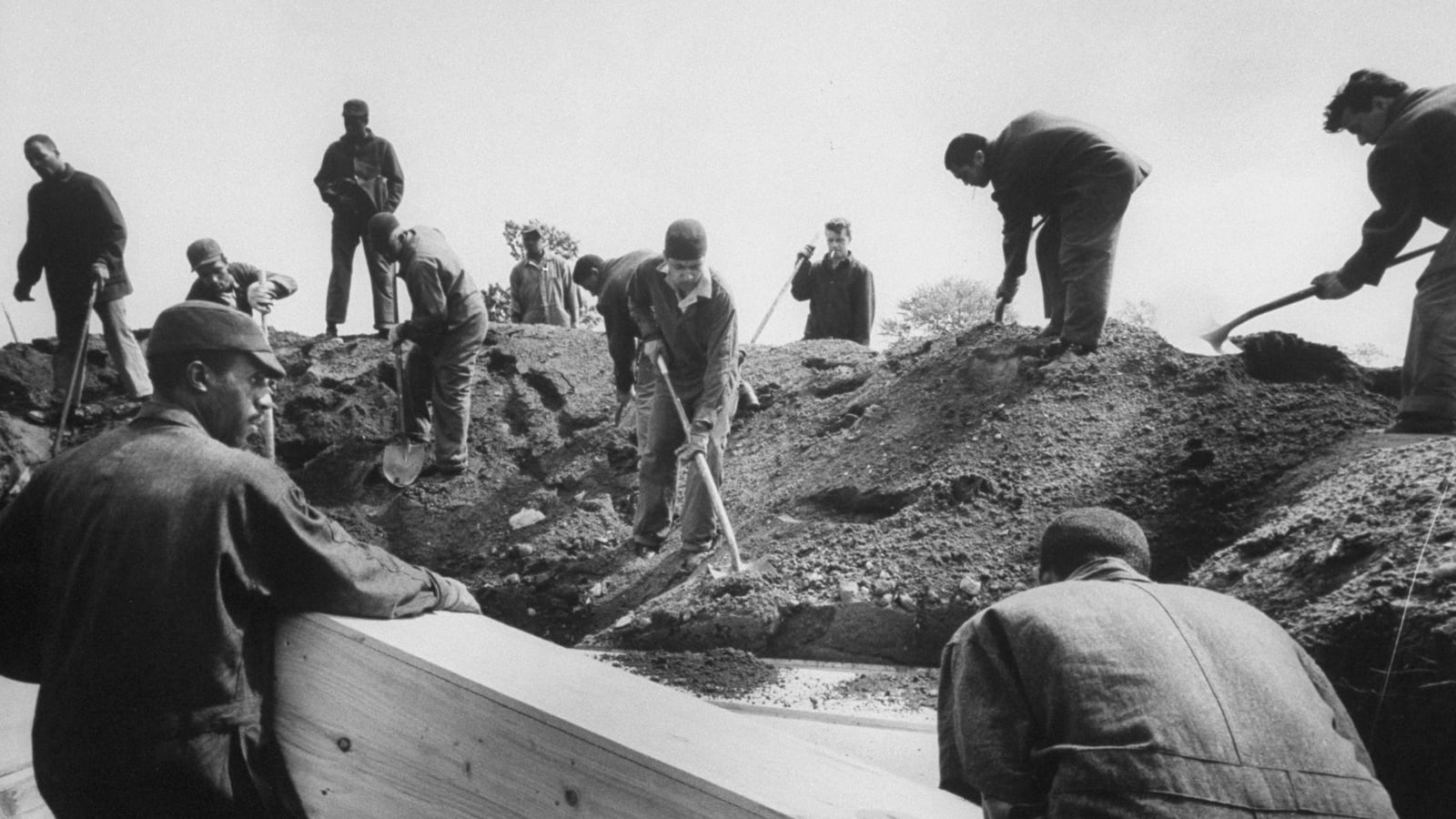At one time or another, a half-mile piece of land off Long Island in New York has served as: a Confederate prisoner-of-war camp, a work house for the poor, a quarantine hospital for Yellow Fever victims, a women’s asylum, a corrections facility for delinquent boys, a Nike missile base, and a drug rehab facility called the Phoenix House.

Today, the 131-acre Hart Island is the largest graveyard in the country and the largest public cemetery in the world, with nearly one million poor, unidentified, or unclaimed New Yorkers laid to rest in its potter’s field since 1869. The only signs of life are the inmates from Riker's Island who are brought in four days a week to dig trenches for future coffins.
As a privately owned island purchased from the Siwanoy Indians in 1654, the landmass got its name from either British explorers who dubbed it “Heart Island,” or as a nod to the “harts” that once lived there when it was a game preserve. Boxing matches were held on the island in the mid-1800s, until it was purchased by the government for use as a Civil War training camp and then turned into a mass graveyard to serve the country’s most populated city.
New York City has established nine potter’s fields, or common graveyards, since the 1600s. The city’s criminals, destitute, and family-less residents have been laid to rest under, areas such as Washington Square Park, Madison Square Park, and Bryant Park, but Hart Island is the largest by far. In 1869, Louisa Van Slyke, a 24-year-old New Yorker, was the first person to be interred on the island. Five years later, up to 50 people a week were being buried there during the hot summer months, so a steamer was commissioned to transport the corpses to their resting places. “These poor waifs and strays of humanity had a melancholy ending,” an 1874 New York Times article reads. “They went out of the world without any friendly solicitude concerning them, and public charity accords to them the decencies of burial.”
Hart Island continued to play double-duty as a cemetery and a grab-bag site for whatever else the city needed, including, half a decade after the burials began, a tuberculosis ward. In 1917, a Bronx Grand Jury deemed the ward unsuitable, and recommended installing a crematorium for future shipments to the potter’s field, calling the current burial methods “insanitary, unsightly, and revolting.”
A few years later, a developer chose the location for a new amusement park for Harlem residents who were barred from whites-only parks. His plans included construction of a boardwalk, dance hall, and eight boarding houses, but the city soon stopped the project.
The island’s next role was housing the excess prisoners from overcrowded jails, and then during World War II, it served as a disciplinary camp for troops. In 1956, Cold War tensions led the military to designate Hart Island a last-resort defense against Soviet nuclear attacks, and they armed the area with an underground Nike battery that housed 20 surface-to-air Nike Ajax missiles. The base was fully decommissioned in 1974, and today it stands ironically across from a war memorial built on Cemetery Hill in 1948 that simply says “Peace.”
Today, Hart Island is devoted solely to the dead. An estimated 1,500 bodies are buried each year in 70-foot plots arranged in rows of six stacked three-caskets high. Around 150 adults or 1,000 babies fit in each trench. One-third of the burials are stillborns and infants whose parents opt for a city burial. So far, 850,000 New Yorkers have been laid to rest on the lonely island. “They’re isolated, they’re forgotten, they’re not recognized. The sad thing is that it’s very much the same way they lived,” Columbia University Professor Kenneth Jackson once said.
Other than the dead, prisoners from Riker’s Island, who are bused over four days a week to pass the hours digging gravesites, are the site’s only authorized inhabitants. Although, visitors are banned, unwanted explorers have managed to sneak in to investigate the site for themselves. Illicit photos from clandestine guests show the derelict Victorian brick structures with windows agape and caved-in roofs, which still boast their old titles, like “Dynamo Room 1912,” formerly home to the island’s power plant.
The Department of Corrections is now in charge of the island, and its management has been controversial. The practice of burying bodies after they’ve only been left unclaimed for a few weeks has led to cases where families aren’t alerted in time to recover their loved-ones’ remains, or where they are unaware that a city burial leads to Hart Island.
When this happens, families of those buried on the island are out of luck—only one gravesite has a marker, “SC (special child) B1 (baby 1) 1985,” identifying the first New York City child to die of AIDS. There is no official map, and each mass grave is simply identified by a granite stump. Family members of the deceased are able to visit the island one day a month, but cannot travel further than a gazebo that is twenty yards from the dock and far from the actual burial grounds. Nearby, a memorial is covered in famous quotes; "God must love the common man, he made so many of them," one reads.
In 1994, artist and filmmaker Melinda Hunt began documenting the potter’s field and petitioning for visitation rights for family members, soon launching The Hart Island Project. She and other advocates have been pressuring the state to allow greater access to the graveyard, and to open the island’s records to the public. “The city just needs to re-examine this whole 19th-century burial process,” Hunt, told the New York Times. “It doesn’t need to be this dark.”
In 2007, she acquired twenty years worth of records of those buried on Hart Island, totaling 58,855 names and the plots they're buried in, through a Freedom of Information Act request. Now, she’s working to bring family members closer to their loved ones. In November, the Department of Corrections granted access for eight women to visit specific graves. “I wasn’t able to be there when she died, so it’s very important to me to get to her final resting place,” one of the mothers said of her infant daughter’s grave. “I want to see where she’s buried, simple as that.”
The activists’ may soon win their campaign for greater transparency. Over the past few years, officials have launched GPS mapping and digital archives to help with record keeping and transparency, and in early January, a city councilwoman from Queens announced plans to reintroduce a bill to transform the island into a park and transfer control to the Parks Department.
For the John and Jane Doe’s of all five boroughs, interment may soon become a little less lonely.






